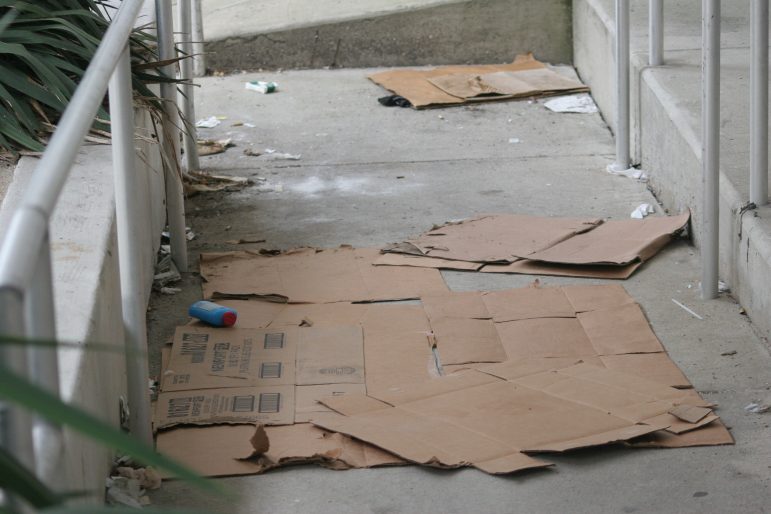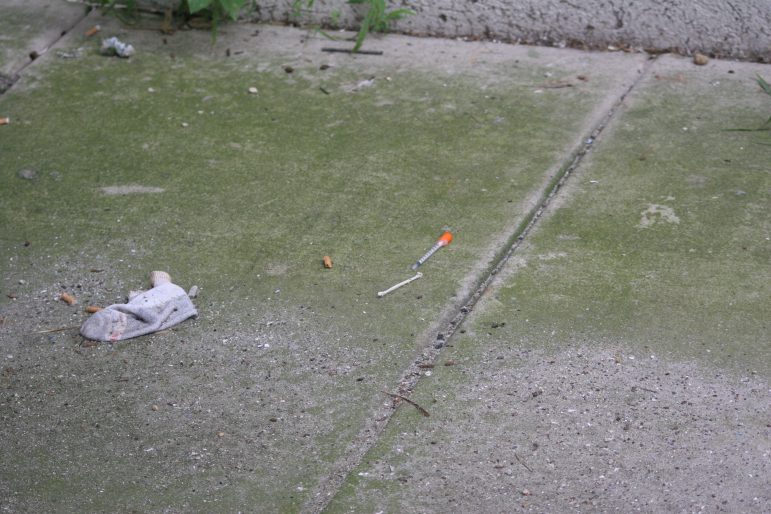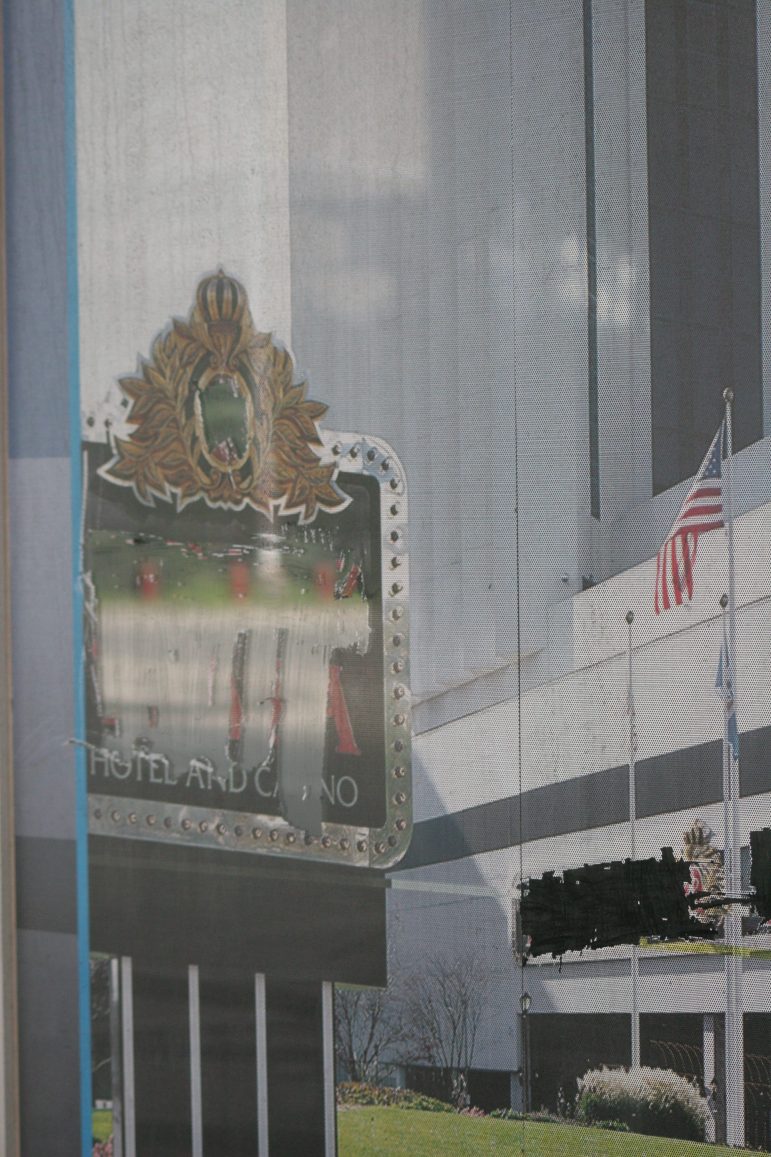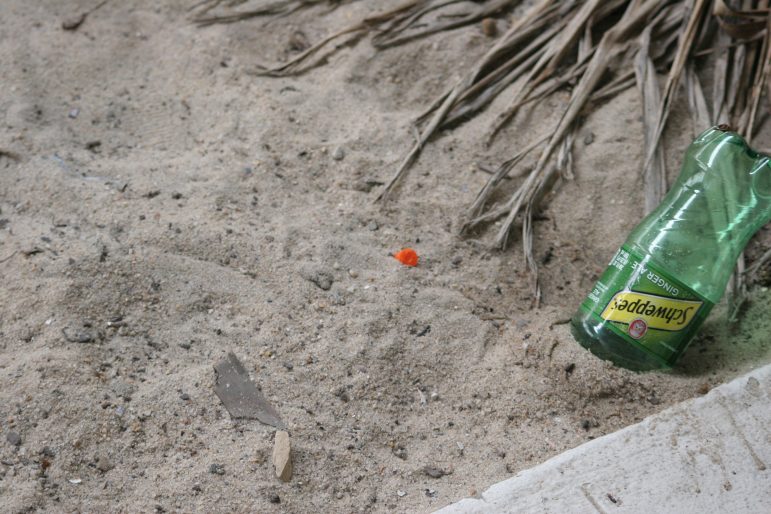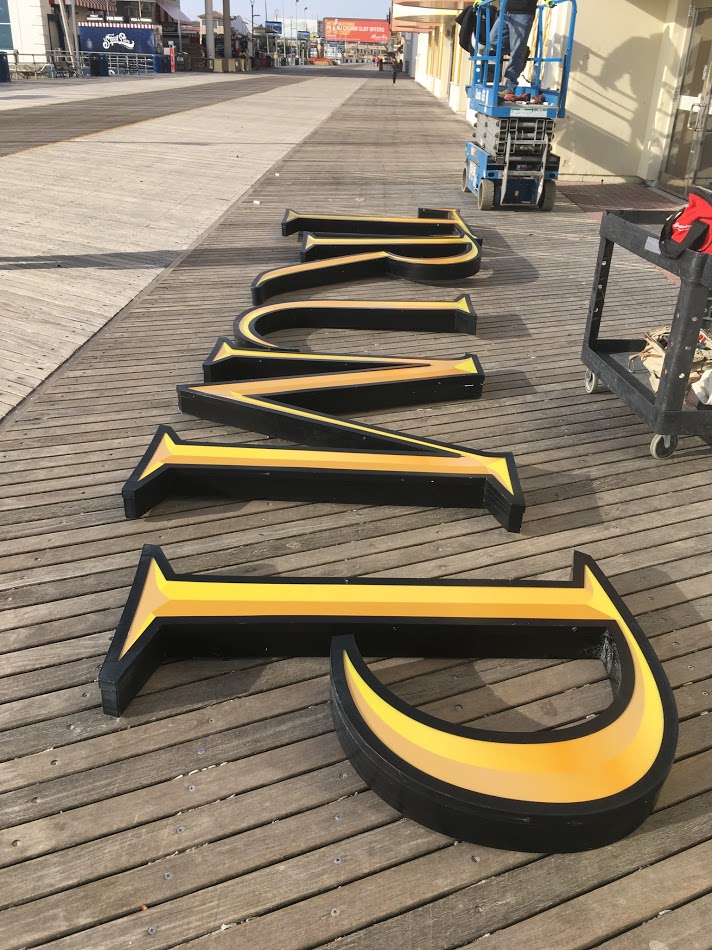Heritage Tourism in the Age of Trump
I. The Auction
The great Trump Taj Mahal liquidation sale opened to the public at 10:00 a.m. on July 6, about eight months after the casino closed and 167 days after Donald J. Trump was sworn in as the president of the United States. It was managed by National Content Liquidators of Springboro, Ohio, a company that specializes in holding onsite auctions of the contents of old hotels and office buildings.NCL has worked on properties for Donald Trump since 1978. They also did the liquidation of the Watergate Hotel (not a Trump property) in Washington, D.C. in 2007, where it was noted in sales materials that “The historical infamy of the complex brought customers from all over the country seeking a piece of the Watergate.”
History was very much the subtext of the Taj Mahal fire sale, which offered customers a chance at a piece of the Donald, recently assured of his own place in history. But since mid-February, the surname of the president has been scrubbed from the property under the terms of a deal between Donald and his friend and economic adviser, Carl Icahn, who until recently controlled the property. There were no TRUMP-branded artifacts for sale at the Taj.
I was there with Levi Fox, a local historian who moonlights as a tour guide. Among his side projects, Levi wants to start a museum to preserve Atlantic City in the Age of Trump, so lately drawn to a close. Between 1984 and 2016, there had always been one—sometimes as many as four—TRUMP-branded casinos in operation in Atlantic City. That ended last year on the morning of October 10 when Icahn closed the Taj amid a dispute with his labor union.
Things were not looking great for Donald at that point. We were a day after the second presidential debate, three days after the leak of the notorious Pussy-grab video and the near simultaneous Wikileaks dump of John Podesta’s hacked emails. Trump did not seem likely to attain the White House. In fact, roughly three dozen high-profile Republicans (the Washington Post compiled a list) were calling on Trump to withdraw from the race and let Mike Pence lead the ticket, as Jesus intended, but there was still, as they say, a lot of football left to play.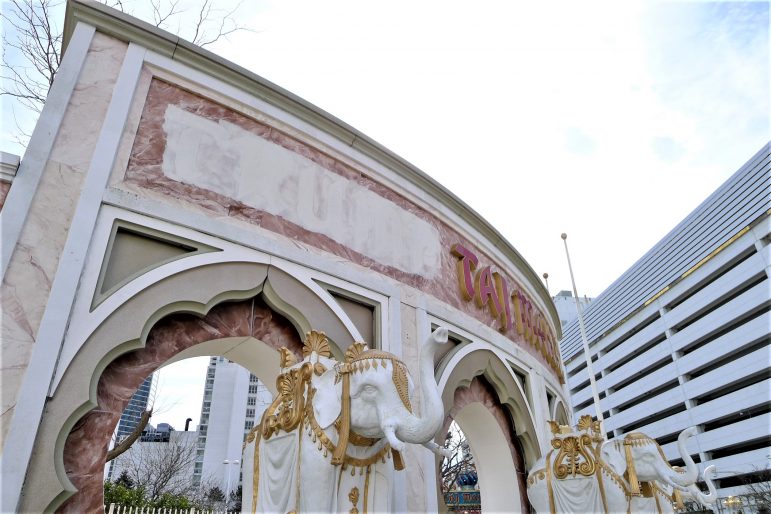
Closed casinos aren’t a new phenomenon in Atlantic City, and they’re not unique to Donald Trump, but they are objects of enormous local curiosity. They used to employ thousands of people. You could see them for miles around, lit up like Christmas trees from across the marshes. Now they’re maintained by skeleton crews of security guards and HVAC repair people. People want to know what they’re like inside—how much damage has been done by the seasons, if they’ll ever reopen, or if they’re dead on their feet and we just don’t know it yet.
Of interest to Levi as a public historian has been the effort to erase the Trump name from Atlantic City’s physical environment, just as we could have used it again—and with an effort to rewrite Trump’s history here just as we should be coming to terms with it. If Donald’s surname is iconic, as Donald says it, you could argue here is where Donald made his name. You could make the case (Levi does) that no building was more closely associated with Donald than the Taj Mahal, and the Taj in turn was the casino most closely associated with Atlantic City. Here is where Trump came to mean TRUMP: that ineffable blend of luxury and accessibility and status anxiety that has so bewitched a stolid 36-38% of the voting public.
Donald took over the Taj Mahal project in 1987, just as The Art of the Deal was being published. He opened it in 1990 as he was becoming a household name. The Taj Mahal was the pinnacle of the Trump era in Atlantic City, when Donald was the biggest show in town, when Atlantic City was the only town on the East Coast for bigtime casino gambling. For a decade or so you couldn’t exit the Atlantic City Expressway without feeling like you were entering the great fiber optic heart of the Trump Kingdom. Parking lots, hotel towers, casino marquees all bore the Trump name in fiery lights. Now, here we were at the end of things, and you could hardly find it anywhere.
Inside, the Taj is a wreck. The atmosphere is tropical, waves of heat and humidity that hit you as you step into the hallways. We were given a list of “procedures, terms and conditions” upon entry. All items were for sale “as-is.” One-of-a-kind items were priced separately. Do not disconnect any electrical or plumbing fixtures. Fire extinguishers are not for sale. The carpets are not (“NOT”) to be removed until some future date (see cashier for details).
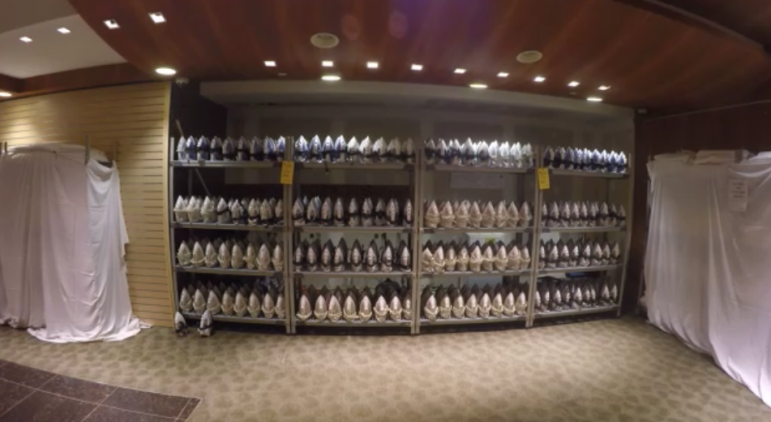
Irons, Taj Mahal
Levi and I took the elevator to the top floor and made our way toward the boardwalk, where there had been some kind of players club overlooking the ocean. I remember thinking it should have been more depressing. Atlantic City has a 37% poverty rate. And that was before the Taj closed. Many of the rooms looked ransacked. Electrical sockets had had their covers removed. Toilet bowls were stained with rust. Wallpaper peeled off walls and fell to the floor in long strips. Behind it, black mold flowers blossomed. Something about a half-stripped bed with an old telephone on it makes any room feel like a crime scene.
It was the first time Levi had been back since October, and he seemed pleased to see people wandering the halls of what looked like a kind of living-history museum, not unlike the one he imagined creating. He said many people, confronted with his idea for a Trump Museum, assumed it would be a shrine to the Donald. As a public historian—someone who studies museums—he was interested in what people conceive to be the role of a museum in society. A Trump Museum isn’t necessarily pro-Trump any more than a Potato Famine Museum would be necessarily pro-potato famine.
“I’ve actually recently kicked around the idea half-jokingly of pivoting to the anti-Trump museum of Atlantic City, because if anything then I think you’d satisfy more of the locals and right off the bat people would be aware that it’s not meant as a shrine,” he said.
Levi was looking for TRUMP-branded objects that had escaped the censors. Failing that, anything to help narrate Trump’s time in Atlantic City, but so far, we’d found nothing that met his criteria. In a few rooms, he looked through the bedside table, found Gideon’s Bible, rifled the pages. Nothing said TRUMP. “They did a bang-up job,” he said.
Still, there were deals to be had. The beds were Simmons Beautyrest, the TVs flatscreen, the tapestries “large” and hand-embroidered and supposedly Burmese-Thai. There were faux-African tchotchkes and lamp shades that emerged from the backs of camels. There were chandeliers everywhere. There were subtle hierarchies. Levi noted a vase on the forty-ninth floor cost ten dollars. The same vase a floor higher had been twelve. There was a room devoted to clothing irons. They were lined up, four-deep, on racks like rows of shark teeth. $8 apiece.
We found a wooden horse statue whose price I didn’t note, more faux-Asiatic statuary ($55), a metal disk with the image of Ganesh (the elephant-head god of the Hindu pantheon) pressed into it ($18). Then, on a sliding-glass door that did not slide, a warning sticker:
“THESE DOORS ARE LOCKED FOR YOUR PERSONAL SAFETY,” and below that: “TRUMP TAJ MAHAL.” It was barely visible, but there it was across the onion dome
“And this is why I was here today, Bill, to show you just how hard it is to fully erase a person’s name and their history from a place—no matter how much they might desire to have it done.”
II. LEVI
Levi is 36, from Somers Point, went to Mainland Regional High School, then to the University of Virginia where he studied history and anthropology. He is doing his PhD at Temple University where his thesis is on the Korean War (the “Forgotten War”) and its memorials. He teaches political science as a part-time lecturer at Rutgers-Camden and teaches writing at Stockton University, where he also taught the class “Adventures in Local History.” He drives a ’95 Chrysler LeBarron two-door convertible that he bought out of state. On his tours, he tells his guests, never buy a used car at the beach (the salt water accelerates rusting). Among his more whimsical scholarly achievements, he wrote the entry for the Republican Convention Barbie in the Encyclopedia of Greater Philadelphia (spoiler: she’s African-American).
One of Levi’s first jobs in high school was tour guide at Lucy the Elephant—the world’s largest elephant-shaped hotel—in Margate. He did a short stint as a Nucky Johnson impersonator after the HBO series Boardwalk Empire prompted a half-hearted attempt by city fathers to capitalize on Atlantic City’s Prohibition-Era history. The Academy Bus Company hired a trolley and two actors as tour guides. Levi was one of the male leads. The hop-on hop-off tour featured lunch at the Irish Pub, an old speakeasy, but that was hardly noteworthy in Prohibition-Era Atlantic City, when everything was a speakeasy. You didn’t need the codeword or secret knock. They just let you in.
About the same time, Levi was commissioned to write a tour of the James Candy Factory—the five-story candy factory on the boardwalk, behind the original storefront from the 1890s where they made both James and Fralinger’s salt-water taffy. In the summer of 2012, he was leading as many as 100 people a day through the factory. Guests paid a modest fee that went toward their first purchase at the candy shop. They wore hygienic kitchen hair nets (blue hair nets for guests, red were for supervisors) while browsing the kitchen up close. But the next season the company was awarded a lucrative national contract that meant new health and safety standards. One of the charms of the tour had been its intimacy: guests could get up close to the action. Now they’d have been behind plastic barriers, and the costs would have been prohibitive.
Levi says there should still be a small museum in the factory (that “no one gets to see”) and he still has dreams of a boardwalk candy museum. “It’s on my top-five list for future AC historic sites.”
The work gave Levi a first-hand perspective on the pent-up interest in Atlantic City history. This town may get twenty million visitors a year, but good luck finding a guided tour.
He started his company, Jersey Shore Tours, about a year ago. To keep overhead low, he offers walking tours of Atlantic City and environs. He leads a Boardwalk Heritage Tour, a Beaches and Buildings Tour, Nucky’s Seaside Empire Heritage Tour (available by request) and a Taste of the Shore Tour (his most popular). He’s written African-American history tours and LGBTQ tours and has plans to write more. He does customized tours for a fee. He performs weddings.
It’s Levi’s hypothesis that heritage tourism could be a boon to Atlantic City—both as an amenity offered to visitors who can extricate themselves from the slot machines, and as palliative care for the town’s terminal image problem (though Levi wouldn’t say it that way). Lowell, Massachusetts used its industrial heritage to rebrand itself as it was sliding into a post-industrial malaise. It’s now got a National Park Service site.
Atlantic City may be a small town, but it has an unusually rich past—from its Victorian origins through the Roaring Twenties to Kentucky Avenue to Snake Alley. Eunice Waymon became Nina Simone in a bar on Pacific Avenue (it’s a cash-for-gold shop now). Martin and Lewis became Martin and Lewis at the 500 Club. Sinatra became Sinatra, a few different times across his interesting career, at the same venue. And now there is a sitting POTUS who forged a global brand beside its shining sands.
Melania’s hometown has seen a spike in FLOTUS tourism since the election. The POTUS’s childhood home is currently listed on Airbnb, so for $600 a night you can watch Fox News beside a “giant cutout” of the Donald. Why not AC?
Levi did a trial run of the Trump Gambling Heritage Tour on July 17, 2016, two days after Donald picked a running mate and four days before he formally accepted the presidential nomination at the Republican National Convention. For purely mercenary reasons, Levi had been hoping for a Trump-Christie ticket, because a Trump-Christie tour would have written itself. We got Mike Pence instead.
At the time, the Taj was still open, still very much covered with TRUMPs, but the situation was delicate. Local 54 was on strike, picketing outside the casino 24-hours a day. Levi never took a tour into the casino.
“I was trying not to cross picket lines, so to speak,” he said.
In September, he started advertising and doing the tour more regularly. It leaves Sunday evenings at 5:30 p.m. from the boardwalk in front of the Taj (though make a reservation). Cost is $16 and guests are encouraged to “wear sneakers and bring water!” for the 90-minute walking tour.
Levi begins with a capsule history of Donald’s involvement in the Taj Mahal, a project he took over, half-finished, from Resorts International. To secure the goodwill of the Casino Control Commission, Donald promised he wouldn’t use junk bonds to finish the Taj. True to form, Donald relied on $675 million in junk-bond financing, saddling the project with onerous debt payments. It ran into its second summer before declaring bankruptcy, the first of four associated with Trump’s Atlantic City properties.
In his heyday, Donald had four casinos in town and was the largest employer in Atlantic City, though as Levi points out, we know now Trump never turned a profit while all four of his properties were in operation. Not that this should matter unless you were one of Donald’s shareholders or lenders—but the bankruptcies became a campaign issue because Donald made them one. Shout “bankruptcy!” around a Trump partisan (it feels like Levi does this on the tour) and you’re likely to hear that Donald used the law to his advantage, as any smart businessman would, which is eminently true, though rarely have the bankruptcy codes been used so enthusiastically as they have been by Donald. 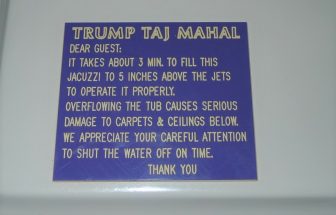
But the issue of course is fraught. South Jersey is littered with contractors who lost their shirts when they did work for Donald and he stiffed them. On the other hand, Trump supporters, at the mention of the B-word, are apt to throw their hands at #fakenews and walk off in protest. Levi joked he has considered writing a Red-State Trump Tour that would highlight Donald’s positives in the city. For instance Levi has met (I have as well) old-time Taj employees who remember Donald fondly (there are some notable exceptions!), at least compared to Icahn, who is Satan incarnate. Atlantic City became a truly international town in the Trump era (underappreciated, Levi says), in part because of Donald’s global profile and in part because he hired loads of immigrants. Vietnamese, Bangladeshis, Latinos all flowed to Atlantic City in waves traceable to the Trump Empire, and many of them have stayed put.
So to recap, a conservative tour geared to Red audiences would highlight Donald’s track-record as an employer of immigrant labor and martyr to deficit spending. Welcome to Trump’s America.
In November, after the general election, Levi launched the Trump Museum to preserve and share the Trump-era history of Atlantic City, even as that was being erased. He called the project a “bi-partisan look at the true legacy of the Trump Plaza, Trump Taj Mahal, Trump Castle, Trump Marina and Trump World’s Fair casinos.” This may or may not accord with the alternative legacy Donald put forth on the campaign trail. It also put Levi at cross-purposes with Icahn, the owner of the Plaza and Taj, who had agreed to remove the TRUMP brand from the Plaza and would soon be pulling it down off the Taj Mahal as well.
Meanwhile interest in Trump and his history was at an all-time high. Levi and Co. were walking a delicate line. They didn’t want to exploit the Donald connection, but they didn’t want to miss an opportunity to tell an important story either. Especially as that story seemed to be growing more obscure all the time.
“Donald Trump’s name used to be all over the Boardwalk,” Levi wrote, and that was months ago. It’s even harder to find the name up there today.
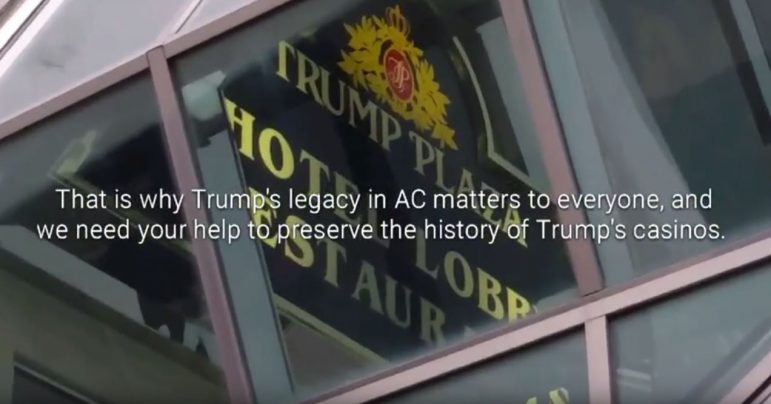
Courtesy of Levi Fox
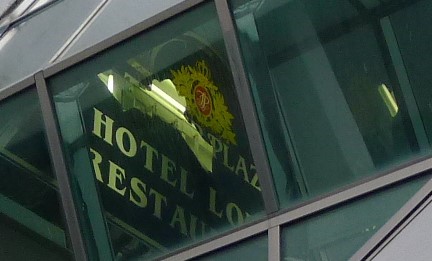
III. Tweetstorm
Last September 26, Arielle Brousse was watching the first presidential debate when she felt, she later said, gaslit at the spectacle of revisionist braggadocio taking place on her television screen. Brousse was 31, living in Philadelphia, but she’d grown up in Galloway Township, a suburb of Atlantic City, where her parents moved in the early 1980s. Her dad had been a piano player in the casinos. Her mom had been a cocktail waitress. Now Donald Trump, the chief architect of the boom that brought her family to South Jersey, was campaigning on the strength of his business record, while Hillary Clinton tried, and failed, to call him out on it. It was infuriating.
Brousse took to Twitter in response, producing a tidy summary of Donald’s actual history in Atlantic City, as she saw it, in fourteen pointed Tweets. “I’ve said it before: I grew up in Atlantic City. My parents, my friends’ parents, my neighbors, they all worked in Atlantic City,” she wrote. “Donald Trump’s systematic monopolization of trade, mismanagement of funds, and destruction of community there is personal to me.” By the next morning, her Tweetstorm had gone viral.
On October 3, Brousse published an essay based on the Tweets in Vox. A few days later there was an op-ed in The Washington Post. Esquire did a story on the Tweets themselves (“This is how Badly Trump Screwed Atlantic City”), as did the Philly Inquirer and the Daily Pennsylvanian. When Hillary’s running mate Tim Kaine held a rally in Philly, the campaign asked Brousse to introduce him.
Trump’s ascension to the top of the GOP ticket and then the White House made Atlantic City an irresistible story for anyone with the credibility to tell it. He is a glitzy TV business showman. Atlantic City is everyone’s favorite East Coast capital of vice and poverty What does this say about the depths of the shit we are in for as a society?
Hardly an hour goes by that I don’t see some message float across social media from someone purporting to know the real Donald Trump, based on their proximity to Atlantic City. “Im from Atlantic City. Ive seen Trump & his hatchet men since I was born. You or no 1 else can tell me about Trump!”
“I was born & raised N Atlantic City and Donald Trump destroyed my island just like he will do this country.”
“I grew up 45 minutes from Atlantic City.”
“I grew up near Atlantic City.”
“Anyone who grew up within driving distance to Atlantic City has known what Trump is for their entire lives.”
Depending whom you ask, this is where Donald tried to kick an “old lady” (Vera Coking) out of her house using eminent domain (she subsequently “kicked his ass in court.”) It’s where he got into bed with the Mob. Or where he laundered money for the Russians. Or where he managed to impressively lose his shirt four times in an industry where the house always wins. For the editors of Fortune Magazine, it was where he got himself paid through “profit override mechanisms” at the expense of his shareholders, even as his public companies failed to earn a profit, an esoteric critique, maybe, but at least Fortune was framing the problem as a struggle between two wealthy constituencies—the obscenely wealthy versus the only merely wealthy, a distinction Donald himself is clever enough to appreciate and to capitalize on.
Confronted with his bankruptcies during a primary debate, Donald called his lenders “killers” to Fox’s Chris Wallace. “These are not the nice, sweet little people you think.” Which I suspect played well around here, where resentment toward the financialist classes is sky high. Donald may be a rich asshole, but he makes you feel like he is your rich asshole—your friend in the One Percent who’s going to fight for you against the Twenty Percent and take back your country.
On July 6, Hillary Clinton came to New Jersey (a reliably Blue state she carried by nearly 13 points) to hold a rally outside the Trump Plaza. The TRUMPs had been taken down, but their remains were still very legible on the dilapidated Plaza façade as Hillary made her case.
“What he did here in Atlantic City is exactly what he will do if he wins in November,” she said.
Hillary was introduced by Marty Rosenberg, one of the contractors who had lost money to Trump. He read from a prepared statement while the candidate hovered suboptimally over his shoulder. The image of the Plaza and the shoddily erased name was supposed to shame Trump before a national audience, but in the event, proximity to his casinos did not inoculate voters against the charms of Donald Trump. The suburbs of Absecon, Northfield and Linwood went Republican by more than five points. Brigantine went Trump by nearly 15. Longport, an even more affluent neighbor, went Trump by nearly 3-1. Even Galloway, where Arielle Brousse grew up, went Blue by only 1.3%, less than 200 votes.
During Marty Rosenberg’s speech, the mic to the P.A. system on the boardwalk wasn’t working properly, and the Clinton supporters at the rally couldn’t hear him talk. Some of them shouted. This went on for a few minutes until, finally, Hillary leaned across and turned the mic on, to a smattering of applause. Half the speech had been inaudible to the crowd, but maybe that hadn’t mattered. The mic that fed to the TV audience was working fine, and that’s who Marty Rosenberg had been brought out to talk to. Hillary won Atlantic City by 62%. And that was about the last time a politician would get a crack at the Trump Plaza photo op.
IV. The De-Trumping
In 2014, Donald Trump filed a lawsuit in Superior Court in Atlantic County against Trump Entertainment Resorts (a successor of his old company) to have his name removed from the Trump Plaza and the Trump Taj Mahal casinos, the two properties that still operated under his brand. In the legal filing, Trump noted that he had “left Atlantic City many years ago” which in Trumpspeak means he still held a 10% stake in the company and accepted money for the use of his name, but conditions at the casinos were “appalling” he said. The properties had been allowed to fall into a state of utter disrepair. Employees of the Plaza had just received WARN notices alerting them to impending layoffs, and this is how Trump knew the Plaza would close. Under the terms of the licensing agreement with Donald, the casinos needed to operate at a certain standard of “luxury” and quality. The WARN notices told Donald they never would be.
At the time Donald’s TV show “Celebrity Apprentice,” which positioned him as a business guru, was in limbo. NBC had filmed a series in the spring, but when the network announced an upcoming schedule the show wasn’t on it. Maybe his association with two beshitted and begrimed casinos was at last hurting the brand.
In his legal filing, Donald cited a story from the New York Times (not yet #failing) that used the Plaza as a metaphor for Atlantic City as a whole. “The wallpaper is peeling, the windows are covered in grime, and worst of all, most of the seats at the slots and gambling tables are empty.” The Plaza and Taj had been beshitted and begrimed for years, but maybe the Times had put its finger on it. Failure was the weakest look.
For years Donald had worked assiduously to spray his name this way and that, all over Atlantic City, leaving TRUMPs everywhere as he worked. Now he wanted them taken down.
At the time, the Taj Mahal was expected to close as well, but by December 2014, Carl Icahn had agreed to a capital infusion that would keep the casino open. A few months later, Donald announced a deal with Icahn (“someone who I have great respect for both personally and professionally”) to keep his name on the casino, where it had been for 25 years. The TRUMPs came down from the Plaza, but they stayed up on the Taj.
And stayed and stayed, through Donald’s campaign launch (Mexican-rapists speech), through endless primaries and debates, through the general election, through Grab-‘em-by-the-Pussy-gate, through Russia-gate chapters one through five, through round after round of totally abnormal shit that made up 18-plus months of American political history. Even as Donald campaigned on a promise to reverse the global economic order that had eroded the rights of workers (American workers anyway), his name stayed on the building, where his friend Carl was in a death match with his union over healthcare and pension benefits.
It stayed through the closing of the Taj on October 10, through election day, through Comey’s announcements and testimonies, through Inauguration Day and the Women’s March. As Trump was the constant obsession of the country, of half the planet, Donald’s many TRUMPS shone still from the top of this building in Atlantic City.
Then a few weeks after the inauguration, they quietly started quietly coming down. I first noticed on February 14 (day 25 of the Trump presidency) during a routine bike ride when I saw the big TRUMPs were gone from their usual positions above the boardwalk entrances. Later, an acquaintance sent a photo of the letters splayed out across the wood. There had been no official statement on the re-branding. The era that had begun with such fanfare was ending in the dark.
A few days later, the TRUMP was erased from the parking lot overlooking Pacific Avenue. Then the name began to come down from the main entrance along Virginia. Media began to pick up the story and document the de-Trumping. Adding to the general Beltway ambience, some of the workers who removed the signage were—wait for it—Russian. By way of Philadelphia. There was a wonderful moment circa February 15 when a man in a cherry picker removed the “T” from the main onion dome above the limo-port on Virginia Avenue. “RUMP” said the rest. Astute local reporters had been waiting for this for years.
The de-Trumping took a brief hiatus, when a former reporter from the Press of Atlantic City happened to be driving past the Taj as the TRUMPs were coming off the Pacific Avenue gates (with their infamous white elephants). Sensing an arbitrage opportunity, Reuben Kramer and a partner offered $250 for the set of valuable relics of the Trump era. A deal was consummated. In a subsequent legal filing, Kramer (or his attorneys) said a casino security guard witnessed the transaction and wished the buyers well, remarking they’d gotten a “bargain.”
By 11:30 on the morning of February 19, bids for one full set of Taj TRUMPs (“ruby-red glass,” think Dorothy’s slippers) had reached $7,500 on eBay, a chance at last to see what Donald’s iconic surname was worth in Atlantic City. The inside bulbs needed replacing, but that neither deterred not surprised anyone. It’s a fun parlor game among AC watchers to track when strategic letters on casino signage go dark, rendering Showboat as HO BOAT for instance, or Bally’s as Balls (that happened), etc.
Here the plot twists: eBay unilaterally pulls the auction citing an investigation by law enforcement. The demo crew may or may not have been in some shit for failing to dispose properly of the priceless TRUMPs. Icahn may have been in similar trouble for hiring those disposalists who’d put at risk the iconic TRUMP brand. Reuben and Co., the only ones who haven’t done anything wrong (they maintain) are accused of having stolen the letters.
Lawyers are engaged. Media reports note that Recycling Urban Materials for Profit, the gag name for the ad hoc company, (“R.U.M.P.”) are looking to get fair market value for the letters ($100,000?) They should know. They are in the business of selling “architectural artifacts and signage for profits.” Well they are artifacts anyway. And the TRUMPs (there were two sets) were “as much pieces of art as they are pieces of history.” Moreover, R.U.M.P. notes, Trump “jealously” guarded his brand, making it “unusual” for signage like this to hit the market. Adding fuel to the fire, the letters were associated with one of Donald’s “more notorious business failures.” After all, it was only the TRUMPs that had been taken off the building. “Taj Mahal” stayed in place.
For what it’s worth, this publication was hoping Ai Weiwei would buy the signs (he used to play down here). Imagine the Taj TRUMPs (that “Sanskript” font was unmistakable) in the hands of a dissident artist with access to the deepest pockets in the art world. But it was not to be. By March, things went dark. If there was a settlement, it went unreported. The current whereabouts of the Virginia Avenue TRUMPs are not in the public domain. They’re lost, like the Holy Grail, to history.
Eventually, the de-Trumping resumed. The big super-TRUMPs from the top of the Taj came down in an impressive feat of workmanship. Other TRUMPs came down less spectacularly. Inside there was the quiet, heroic work of scrubbing the TRUMPs from the property. But by July, the name was basically gone.
Apart from that sticker on the glass door, Levi and I found two other TRUMPs in the Taj. One was above the bike rack, telling bike-rack users if anything left there was stolen, it was not the responsibility of TRUMP. The other was a placard in a bathroom—instructions for neophytes on how to fill the jacuzzi (pretty Trumpian when you think about it).
“DEAR GUEST;
IT TAKES ABOUT 3 MIN. TO FILL THIS
JACUZZI TO 5 INCHES ABOVE THE JETS
TO OPERATE IT PROPERLY.”
Failure to do so could cause “SERIOUS DAMAGE” to the carpets and the floor below. And above it were the words, TRUMP TAJ MAHAL.
In the meantime, a deal had been reached to sell the Taj to a partnership of politically-connected developers who would turn it into a Hard Rock casino. The announcement, made on April 5, was familiar to students of disaster capitalism: a grandiose unveiling, accompanied by promises to spend lots of money. Nearly $400 million. Three thousand jobs created. An E Street cover band was on hand to usher in the new era of promise. An actual E Street band member (Little Steven) was on hand for the meet-greet. A few weeks later, a quieter ceremony where the developers apply for tax breaks. But the project is a necessary step in the salvation of the region. For forty years Atlantic City has had casinos. For forty of those years, its salvation has remained a work-in-progress. But maybe this time it would be different. Just another role of the dice.
Levi likens the de-Trumping to a kind of damnatio memoriae, the ancient Roman practice whereby elites were sometimes posthumously condemned, their names expunged, their statues effaced, if their policies or personalities fell out of favor with the current administration. The names of traitors could be obliterated from history. But it’s not like Atlantic City wants to erase Trump. It’s more like Trump, having ascended to the heavens, wanted to erase himself.
For a while, after the TRUMPs on Virginia Avenue (the white-elephant TRUMPs, Reuben’s TRUMPs) had been taken down, their outlines could still be seen in the dust and stone of the gates. A coat (or a few) of paint had been applied, but the word was still plainly visible. More coats have since been added, and now all you see is a big white rectangle where the name of the forty-fifth president used to be.
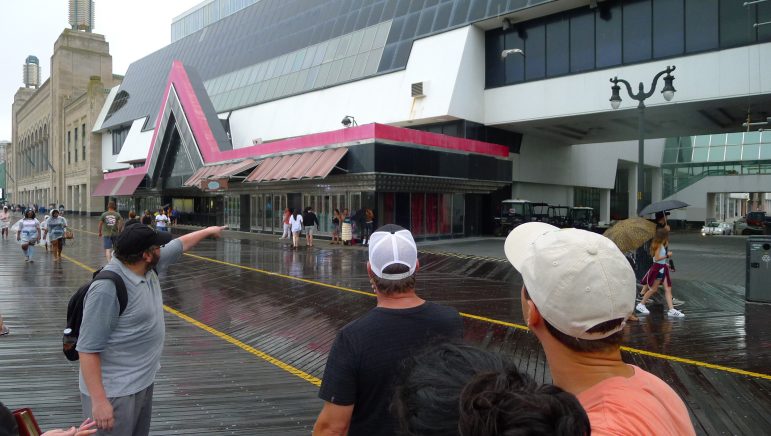
Levi, in front of the Plaza
V. Persistence of Donald
The day I took Levi’s Trump tour, Business Insider ran a story, a photo essay really, on Atlantic City’s transition in their words from “bustling tourist hub” to “ghost town.” It was the kind of piece that makes locals pull their hair out, full of novel historical claims like, “Atlantic City’s true heyday was in the early 1960s, when traveling cross-country was not economical for most families.” Many of the photos appeared to have been taken in February, at the wrong time of day for tourists. They were beautiful though—eerie, empty parking lots, incandescent negative spaces. It’s not that anyone thinks Atlantic City’s a success story. But the decline narrative has been playing on repeat for fifty years. The casino industry still draws tens of millions of visitors and produced $3.7 billion in revenue last year. It works for somebody. Maybe municipal despair is just a byproduct of the manufacturing process.
It was muggy and generally pretty gross at 5:30 p.m. on the boardwalk when Levi began to lay down his history game to a small audience: a couple from San Antonio, a Kentuckian, and a New Jersey native (in town from New Orleans)—though full disclosure: these last two were there sort of artificially because of me. The tour is not all Donald. Atlantic City may have torn down its old Victorian hotels, but there is still the residuum of the old days: a mural on a ceiling, the façade of an old theater, a compass on the ground. They’re surreal and incongruous and evocative. Levi keeps it moving.
A light rain began to fall. Yet try as I may I could not see for the crowd on the boardwalk the “ghost town” proposed by Business Insider. There were many POC, and many of them speaking languages other than English. There were white people who scanned as not-especially affluent. Immigrants and the white working class in other words—the two shibboleth constituencies of the 2016 election cycle, whom you’d think would not vacation together in the same town. But Atlantic City is where the hillbilly breaks bread with the refugee. Naturally they remain invisible in the pages of our respectable media.
There are indigent people. Many are military veterans—or at least say they are. Many are drunk or high or just struggling, otherwise, to transition back to life among the straights. Many come here to party—drawn by AC’s reputation or its robust social-services—when the line between partying and crying out desperately for help has about thinned down to nothing. You see people talking to themselves. people crying. People panhandling. People bleeding from headwounds. People passed out. But there are also families—Latinos, Southeast Asians, African-Americans, just enjoying the evening by the beach.
Drugs and their effects are everywhere. Opioids and alcohol aren’t unique to Trump’s America—or Atlantic City—but in counties with high levels of opioid abuse and other “deaths of despair” Trump outperformed his Republican predecessor Mitt Romney by 10% across New England, and 16% across the Midwest. Donald could stop being president tomorrow, and we’d still be dealing with that crisis for years. From this perspective, you feel less like Donald Trump created Atlantic City than Atlantic City, in some way, created Trump.
From the Taj, Levi moves down the Boardwalk to Resorts, where there is a Margaritaville restaurant. He has to shout to be heard over muzak versions of Jimmy Buffet standards. Also a little helicopter takes off and lands every few minutes from the end of Steel Pier. Noise pollution could be an impediment to heritage tours.
The tour ends at the Plaza, closed nearly three years ago. On the ground floor is a bar and restaurant called EVO. If you stand on the boardwalk and look through the windows, you are looking in effect into a museum or time capsule. The EVO remains as it was when it closed, a few months after the Plaza itself. “Because, on the night of the final dinner, it was no one’s job to pack things away,” Levi says. The water glasses are still on the tables. As are the white tablecloths. Behind the bar, low red lights still shine through the liquor that’s still in the liquor bottles.
Levi says it makes him think of the War of 1812, when British troops invaded the capital, the found the White House evacuated, the President’s dinner still on the table, the diners fled.
If that seems too esoteric, he goes with “zombie apocalypse.”
In front of the Plaza is the spot where Hillary gave her speech last summer. The TRUMPs have since been covered over more thoroughly, but if you look through the main entrance, through two sets of glass doors, you can see the brand engraved on a metal plate.
When Hillary made her speech here, she was “trying to highlight the stark contrast between the promises President Trump had made about the future of Atlantic City and the realities of the community that we all see around us,” Levi says. Those realities are still with us, still stark, but Donald’s surname is gone. And he’s the president.
The last stop is Columbia Place, the public street that separates what used to be two towers of the Plaza. A pedestrian overpass spans the street. It is now closed, but you can look up, through the windows, and see the big sign that used to point visitors to the “HOTEL LOBBY RESTAURANT.” Above it is the faux-royal logo above the words “TRUMP PLAZA.”
A few months ago, Levi was showing a film crew from Madrid around the outside of the Plaza when he took them to the spot, expecting to see one of the last remaining TRUMPs in Atlantic City. To his surprise, it was gone. You could still see the sign, but someone had smashed the glass, leaving a jagged hole where the name used to be.
It’s “eerie” Levi says.
In Levi’s view, Donald never really put a lot of his own money into Atlantic City. He took a lot of wealth out, then bragged about making “smart” business decisions that had severe consequences locally.
“Trump only wanted to be associated with a first-class establishment,” Levi says, “Yet he himself oversaw the decline of this property and so much of the rest of Atlantic City.”
The after effects of the decline are what you see today. And extraordinary measures have been taken to make sure Donald’s name’s not attached to those consequences.
“It’s one of the things right now that Atlantic City could potentially use as a way of bringing new attention to the town. And its future.”
When I was on the tour, the guests seemed amused at the lengths that ownership had gone to erase the icon, and the shoddy way they’d done it.
“Wow, that’s insane,” someone said.
“I bet they threw stuff at it.”
“I imagine not-the-right tool.”
Levi was happy someone had finally appreciated it—the de-Trumping—the way he had.
He was encouraged to do a duckface in front of the sign. Photos were taken.
“I’m going to make it my profile picture,” someone said.
“That’s hashtag Jerseyshoretours.”
***
Levi’s efforts to preserve the Trump history have generated objectively great coverage in the fakenews press. He’s been written up in Germany (Handeslblatt), Francophone Canada (le Soleil), Spain (La Vanguardia), the U.K. (BBC), Japan (NHK), the Netherlands (De Telegraaf), etc. The crew from Madrid did a story, but he’s yet to update his postcard.
Atlantic City spends—or spent—millions of the public’s funds marketing itself (to grind gamblers). On a shoestring Levi probably got more international press for the city than its marketing apparatus got in years, but it was not the kind of press that was smiled upon by our casino benefactors. And so far the attention has not resulted in a fundraising windfall. An Indiegogo campaign to raise funds for a lawyer raised $230 (though Levi’s since found someone to do his nonprofit paperwork pro bono). But people are interested in telling their stories for the book project that would accompany the museum, and they’ve already gotten offers for artifacts.
Wandering the Taj, Levi and I decided the word TRUMP may have been erased from his properties, but everything still somehow says Donald—the leopard-print bed stool, the fainting couches, the big signs announcing CHAIRMAN’S PARKING. The mix of mass opulence and status insecurity—they made Atlantic City an excellent provining ground for a right-wing demagogue.
A few weeks ago, Levi was walking up Pennsylvania Avenue next to the Taj when he noticed the TRUMPs had been scratched out of the windows of the old Human Resources office, formerly a little supernova of TRUMPs. In the old days, the windows were covered with pictures of Donald’s properties alongside the smiling faces of the imaginary workers who staffed them, so to de-Trump the H.R. office, someone had to erase the TRUMP brand from the picture of the Taj Mahal on the side of the actual Taj Mahal.
When I went back a few weeks later, a scaffolding had been set up, and there were I.V. drug users camped out on the steps. It was the kind of metaphor that seemed too crude to be true: The Trump H.R. offices—which had once promised employment and prosperity and access to the Trump train and all the benefits that entailed, was being used as a shelter for heroin abusers. I doubted anyone in the 36-38% who think the president’s doing a good job would believe it. But there’s something Trumpian about that too. The Trump machine makes its own fake news.
Meanwhile, in the real world on Pennsylvania Avenue in AC, life went on. There were cardboard boxes, a stray sock or two, a Bud Light Lime-a-Rita can, a container of talcum powder, cigarettes, ginger ale, cottons, a Dunkin’ Donuts cup and the orange caps of hypodermic syringes sticking out of the sand. But the president’s brand name had been removed, meticulously, if haphazardly, from the property, so the legal exposure to ownership was minimized. It wasn’t Donald’s problem anymore.

